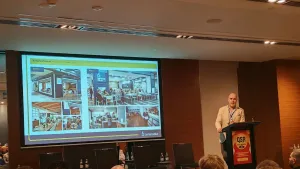
How QSRs can maximise their outdoor digital displays
The screens can be used for various purposes such as displaying menu, promotion, or entertainment.
As an up-and-coming young executive, Fred spends most of his waking hours working on an important project for his promotion. He has little to no time preparing his own meals so he always resorts to takeaway, drive-thru, or delivery. On days when his mind is preoccupied with work and he is too exhausted to think of what and where to eat, he simply stops at the first fast food outlet he sees on his way home to grab a quick meal.
Several QSRs compete to get a bigger share of wallet from customers like Fred. Whilst an elaborate, extensive marketing campaign covering all traditional and social media platforms certainly matter, sometimes it comes down to what customers see whilst they are on the road.
In such circumstances, outdoor digital displays play a huge role in convincing customers to choose one brand over another from the comfort of their own vehicle. For this purpose, promotional screens have become even more important than those displaying menus as QSRs compete for the consumer dollar.
According to Luke Irving, founder and CEO of Fingermark™, with the hospitality industry hit hard by the pandemic, QSRs were already geared up to market to consumers with their digital displays. Moreover, the ease of changing content on digital boards allows QSRs to promote relevant offers based on the time of day, and target core markets with different offers on different time periods.
“Outdoor digital displays help QSRs engage customers by acting as brand billboards. The tantalising imagery of food, people enjoying the food, and other eye-catching visuals evoke an emotive response and connects customers to the brand. Meanwhile, promotional boards highlight special ‘limited time’ offers to drive urgency and immediate gratification,” he adds.
With a centralised content management system, QSRs can maximise the impact of their digital displays. This allows brands to effectively target customers by controlling where and when certain messages are shared along the customer’s path to purchase.
“The larger QSRs have a centralised design and CMS at their head offices (via internet) which ensures consistency of message across all outlets, although independent operators could manage content themselves if permitted,” says Irving.
Digital displays are also a great tool for advertising and marketing as the screens can be used for various purposes such as displaying menu, promotion, and/or entertainment. In order to make the most of outdoor digital displays, QSRs need to strategise as to what kinds of messages and images are most effectively communicated through this channel.
Irving suggests that promotional screens at the drive-thru entrance or roadside are effective in enticing people to purchase.
“Think of it as a billboard. To grab customers’ attention, the displays must be easy to read from a distance and show simple, single-minded messages such as an image of a product with the limited time offer or special price in oversized but minimal words,” he adds.
As QSRs continue to change the way they engage with customers over time, it is important to nail all customer touchpoints leading up to a purchase. Smart, sturdy, and sophisticated outdoor digital displays are a great way for QSRs to connect with customers, especially to communicate new products and special offers as they can easily be changed out at relevant times to target specific customers or drive increase in traffic at slower times of the day.























